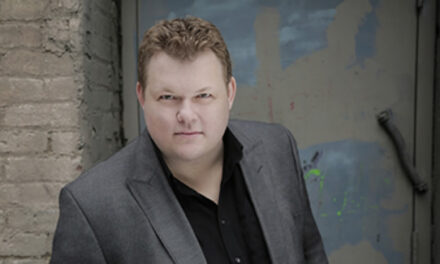In a year so replete with good stuff, including twelve commissioned works, in Carolina Performing Arts’ 2012-13 season, one could start to feel overwhelmed. And one could start to get really tired of Igor Stravinsky’s The Rite of Spring, the focus of CPA’s series within a series examining that era-changing work from many points of view. However, that’s not happening. Instead, each new performance increases interest in that complex music, the dance that accompanied it — and the ones that have followed — and the ideas that swirl around them. On January 26, (delayed one day by icy weather) CPA presented in Memorial Hall what may be the most intellectually important of its dozen commissions this year, A Rite, a collaborative production of the Bill T. Jones/Arnie Zane Dance Company and SITI Company, headed by Anne Bogart. This brawny baby was three years from conception to premiere.
Bill T. Jones has moved further and further into dance theater over the years. While he has an unerring sense of spectacle, I have never felt his command of theater idiom equaled his command of dance. Working with Anne Bogart and the highly physical SITI Company, as well as his associate artistic director Janet Wong, Jones and his company have found a much stronger theatrical voice. In a discussion after the dress rehearsal January 24th, one dancer commented on the literal difficulties of speaking while dancing. Another spoke about how enlightening it had been to him to watch the actors preparing their roles. Both companies had begun to call their members “dactors” rather than dancers and actors. While it was certainly possible to distinguish them in A Rite, the performers all gave both choreography and theatrics their due.
A Rite is not a dance set to an unbroken presentation of the music. It examines, with words and bodies, the content, context and continuing fascination of both Stravinsky’s score, the libretto and settings of Nicholas Roerich, and Nijinsky’s dance. It does progress, more or less, from beginning to end of the music, in a spare and effective set made of scrims and light (at one point the whole backdrop looks like piano keys) with the dactors well differentiated by their costumes. It’s clear we should take them as a group of people, not a troupe of aesthetisized bodies. Although it fractures and fragments the music, A Rite feels complete (which is funny, because the ending was still in question at the dress rehearsal). The music conveys powerfully a sense of things going around, of circles, cycles, and this performance sprang loose an old memory of playing with a train set. If your timing was good and your hand adept, you could snatch a car off the moving train, examine or exchange it, and re-hook it to the train the next time it circled around. Jones and Bogart were doing something like that, pulling ideas and emotions out of the music, prodding and questioning them, then smoothly rejoining them to the pounding rhythm accelerating towards its inevitable conclusion.
From its first scene, A Rite emphasizes the martial aspect of the music. A line of dactors surges forward from upstage. The threatening bodies spread to the wings on either side. Fists in the air, they march relentless toward the audience before the movement devolves into mad, circling goose-stepping, and then into a rhythmic shaking that recalls some of Nijinsky’s movements (as reconstructed by Millicent Hodson). A shell-shocked soldier stumbles on, stuttering, trying to remember, trying to forget. He’s clutching a little tape player, and when he punches it on, The Rite’s famous bassoon notes slip out, tinny and scratchy and terribly sad.
Soon, the other dactors return, another line forms and dissolves and reappears as a mass which flies apart into individual particles which coalesce into line and volume and blow up again…in this way, the choreography stays with the pulse of the music and provides a framework for some wonderful ensemble dancing in the inimitable Bill T. style. Within this structure, there are quite a few remarkable scenes and intriguing speeches by characters generally recognizable by type (although the academic woman was modeled directly on UNC music professor Severine Neff, who inadvertently sparked this Rite Centennial while trying to get some attention for her man Schoenberg). They range from the prosaic to the poetic; from ludicrous to cruel; from sorrowing to hopeful, and have a building mystical force of their own. A Rite so gets you on its wavelength that all of them make sense at the moment of hearing, even particle physics and the relativity of time and space; even the bits in Japanese.
Bill T. Jones has been concerned with war (what is it good for) before, so it wasn’t particularly surprising that he turned the sacrifice of the maiden from Roerich’s libretto into the sacrifice of men in wars. “What they don’t tell you about killing is that you are killing yourself.” There is a dark resignation to A Rite that I think comes from the bleak realization that no amount of art or logic will stop war. But hope is there, too, lovely irresistible hope. At the end, a single voice quavers out from the killing field. It is joined by others, and the dead rise up singing, beautifully singing the hundred-year-old notes. The circle is unbroken.











